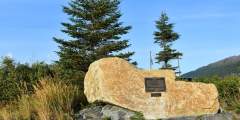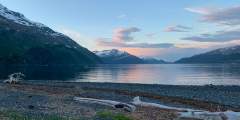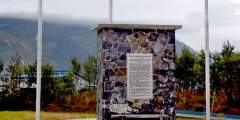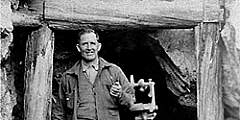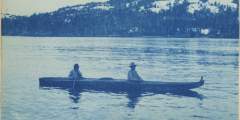Whittier Points of Interest
Show Map
Points of Interest
The Pioneer Monument commemorates residents of Whittier who have passed away. Flags fly above the monument and names are added periodically, as long-time residents pass.
The monument, a plaque on a 13-ton rock, can be found in the town’s Triangle business district amidst a wild rose garden. It’s a tribute to those who It’s a fitting tribute to those who lost their lives during the 1964 earthquake.
Quick: what’s the longest combined rail and highway tunnel in North America? It’s the Anderson Memorial Tunnel, and you’ll drive through it on the scenic and historic drive to Whittier. The Kenai Mountains-Turnagain Arm National Heritage Area is a place whose valleys and mountains, communities and people tell the larger story of a wild place and a rugged frontier. This audio guide gives you the inside scoop on its fascinating history. You’ll… ...more
In Prince William Sound you’ll find some 150 glaciers packed into an area just 70 miles wide. These are the few that you shouldn’t miss!
One of Whittier’s true gems is hidden in plain sight. The Head of the Bay is literally that: Where the shimmering waters of Prince William Sound meet the shores of this charming town — and it’s a beautiful spot to visit. Come with a picnic and take it all in as you relax. You’ll also find a metal fire ring, perfect for a summer evening bonfire. Want to camp there? It’s more popular with those driving RVs or campervans than tent campers.
In 1943, The Army Corps of Engineers built a monument commemorating the effort of building the 2.5 mile long tunnel through the solid rock of Maynard to realize the vision of Whittier as a year-round ice-free port. The monument was recently restored in a new location with the original plaque.
Bald eagles. Brown bears. Black bears. Humpback whales. Orcas. Stellar sea lions. Harbor seals. Sea otters. Moose. Wolves. 200,000 seabirds of over 220 different species. You can find this impressive collection of iconic Alaskan animals right in Prince William Sound. Here’s where to go in each town for the best wildlife-viewing opportunities!
The area of Whittier has long served as passage between Prince William Sound and Turnagain Arm. The Alaska Engineering Expedition envisioned a rail line out to this largely unsettled area back in 1914, but it was the U.S. Army that made Whittier where and what it is.
The Sugpiaq are maritime people of south and southwest Alaska, adept at utilizing water-based resources and handling intense coastal weather. The name Sugpiaq comes from the word “Suq,” meaning “real people.” Alutiiq, the Sugpiaq term for the Russian name “Aleut” has been adopted by many contemporary Native people of this diverse heritage; both terms are commonly used today. The Sugpiaq who inhabit the outer coastline of the Kenai Peninsula… ...more
Built during WWII as a top-secret military project, today Whittier is a great jumping-off place to explore Prince William Sound. To connect Whittier with the rest of the Alaska Railroad, during the war the military constructed a massive tunnel. Today the expanded tunnel is the longest combined rail and highway tunnel in North America.
Harbor seals and sea otters are common sights in the Whittier Small Boat Harbor. You might also see salmon enthusiastically leaping from the water, a sight that cues locals to run for their fishing poles. King salmon run from May through early-July. From late-July through early-September, a run of silver salmon brings anglers from throughout Southcentral Alaska.


